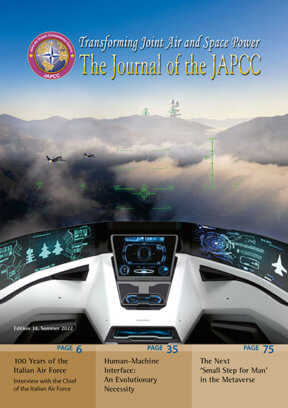Introduction
On 28 October 2021, when Meta1 founder Mark Zuckerberg presented the Metaverse, a series of interconnected virtual worlds capable of entirely transforming the way we communicate, few people were able to understand whether this was just another rebranding and marketing hype or the next evolutionary step in our lives; the creation of an advanced, networked Virtual Reality (VR). One of those who realized the importance of this new technology was Bill Gates, the Microsoft co-founder, who foreshadowed during a Ted Talk event the threat posed by an infectious virus2 five years before the actual COVID-19 pandemic outbreak.
‘Over the next two to three years, virtual meetings will shift from the 2D camera image grid format to a 3D space with a digital avatar’,3 he said in his yearly blog in December 2021. With the confidence of his almost prophetic past predictions, Bill Gates saw that people will meet virtually in the near future, in interconnected digital environments with the help of ‘avatars’,4 realistically simulating an in-person meeting.5
Due to the pandemic, humankind has been forced to make monumental leaps in technology use. Technology has grown, changed, and accelerated so rapidly and widely in the last two years, where normally it would have taken decades. In such a challenging environment, are organizations, such as NATO, capable of reviewing long-established practices and adjusting traditional operating procedures to maintain their strategic edge?
Next Big Thing
During the 1990s, the use of the Internet, computer networking, and digital communication proliferated worldwide and forever changed the way we live and interact. These technological innovations constituted the epitome of the 4th Industrial Revolution6 and the beginning of the Information Age. Since 1991, the World Wide Web has become publicly accessible, going beyond the United States government’s and universities’ borders. It needed less than a decade to expand globally. In comparison, the first 2G cellular network was released in that same year and less than 30 years later, 5G networks are up and running.
Today, what is happening gradually is not only the Internet’s transition from two-dimensional (2D) websites to three-dimensional (3D) web spaces,7 but also the emergence of its limitless successor, the Metaverse. In this Metaverse world, when it is fully developed, people will appear as self-designed avatars. They will engage in everyday activities, like conversations and flirting, going as far as squabbling and even to the extremes of espionage. A limitless virtual reality will allow people to inhabit and control characters that will move and socialize in a digital space similar to a multiplayer online game. This means that we could not only play games, talk, watch movies, attend events, shop, stroll, and do virtually things similar to those in the real world, but also interact with the real world in countless and unpredictable ways.8 Like the universe, the Metaverse includes both space and time and is not only a form of matter, but also a form of energy. In particular, the Metaverse ‘is about a time when basically immersive digital worlds become the primary way that we live our lives and spend our time’.9 The line between the real and the digital worlds will be increasingly blurred, and the Metaverse will become a vital venue to operate socially and resolve disputes or conflicts.
The infrastructure and processing power is still insufficient to replace the existing 2D internet with the envisioned immersive, networked, 3D virtual world. Although hundreds of hyperscale cloud data centres10 have already been built worldwide to efficiently support robust, scalable applications,11 the fully formed Metaverse with its countless live, synchronous connections will need many more investments by the big data-producing companies such as Alphabet, Amazon, Facebook, Apple, or Microsoft. Surprisingly, the most influential factor that accelerated and revolutionized the way we work and interact with each other is undoubtedly the COVID-19 pandemic.12
According to Bill Gates’ predictions, the pandemic’s impact on digitization will take at least another decade to be realized. In the meantime, new technologies and products must be developed to become the ultimate gateways into the Metaverse (VR headsets, smart glasses, haptic gloves) and enhance people‘s interactions and shared experiences. Simultaneously, due to the exponentially growing number of interconnected devices, the attack surface and the potential entry points for hackers will drastically increase, undermining the effectiveness of the existing network intrusion detection systems.
The convergence of the physical, augmented, and virtual reality in a shared online world, the ‘embodied internet’, will offer unprecedented interoperability to its ‘citizens’ and unforeseen security challenges to governments and institutions. No single company or authority can run the Metaverse exclusively; thus, various multi-players and groups will operate it decentralized. Digitization is here to stay and will affect the way people work, learn, or entertain, as well as the way national and military interests compete and fight.
The Future Operating Environment
In such a digitized world, which gradually and steadily shifts towards becoming a virtual one, defence and security policies and strategies have to adapt accordingly. Emerging and disruptive technologies can generate both risks and opportunities. Globalization, communications advances, and dual-use technologies, such as artificial intelligence, quantum computing, machine learning, big data management, blockchain networks, autonomy, and biotechnology, have the potential to threaten NATO’s military technological superiority. The future defence environment requires not just new technologies, but also new ways of approaching and leveraging these technological challenges.
The new information realm, reinforced by advanced ‘Social Media 2.0’13 applications, does not only lead to technological developments, but also to sociological changes. The dissemination of fake news coupled with information warfare campaigns can influence, manipulate, demoralize, or even radicalize public opinion and behaviour, undermining the trust in the democratic institutions and processes.
The Alliance understands that it ‘cannot succeed in tomorrow’s fight with yesterday’s approach’.14 NATO needs to continuously transform ‘to shape and contest the environment and to keep the edge over our adversaries and competitors, now and in the future’.15 The operational environment changes at high speed. The future military battlespace is widening, demanding more collaborative, efficient, digitized, secure, and cyber-resilient efforts across the Land, Air, Maritime, and Space domains.16
The NATO Multi-Domain Operations approach recognizes and effectively addresses the increasingly blurred geographic and organizational boundaries, under the purview of the pervasive information environment. A modern decision-making cycle needs to be able to create decisions at the speed of relevance, despite the constantly growing volume of information that has to be processed. The traditional environmental and cultural domain boundaries need to be broken down17 as the domains’ current static, fragmented, command and control (C2) architectures prove insufficient. The new approach should leverage the future cloud-like combat environment by instantly sharing and transmitting data across multiple communication networks, from both the physical and non-physical domains.
Today, billions of interconnected smart devices and sensors, like ‘everything-to-everything’ networks,18 need web-based, decentralized, and agile C2 architectures to enable the decision-making process to adapt rapidly and autonomously to the mission’s environment with minimum human intervention. In addition, brain-computer interfaces can transform the brain’s low-electrical activity to strong digital signals to be analysed by external devices and translated into commands and desired actions.
Decision-makers, irrespective of their hierarchy level, need ‘access to information to allow for simultaneous and sequential operations using surprise and the rapid and continuous integration of capabilities across [multiple] domains’.19 Leveraging new technologies will help rapidly understand the battlespace, direct forces faster than the enemy, and deliver synchronized multi-domain effects.20 If all the necessary information is available in time for each process (planning, deployment, engagement),21 then the so-called ‘information superiority’ can be achieved, leading to better situational awareness and decision advantage.
Conceptualizing the Virtual Meta-Domain
As the physical environment is progressively transformed into live, data-bound, digital replicas to create the so-called Digital Twins22, where every physical object is linked to a virtual counterpart, new operational platforms and advanced technologies need to be applied in the formulated, mixed-reality ecosystem. The ongoing convergence of physical and digital objects has the potential to revolutionize and stimulate future military operations by instantly leveraging all allocated sensors and effectors across the physical and non-physical domains and synchronizing the desired effects accordingly.
‘A digital twin-based approach offers the prospect of consistent, reusable, and available data’23 to advanced military systems and platforms providing previously impossible benefits to supply chain management, testing, training and experimentation capabilities, as well as, introducing immersive mission planning processes. Gamification principles24, based on advanced simulations with a high level of authenticity and credibility, can ‘improve the complex and costly process of military flying training by incentivizing the training process’.25
Moreover, the integration of operational platforms based on advanced analytics, data modelling, ingenious simulation, autonomous control, brain-computer interfaces, and live interactions can transform and accelerate the decision-making process while ensuring its accuracy. Information superiority and effective situational awareness are essential in a dynamic, multi-domain combat scenario. All assessed and relevant data needs to circulate at high speed and be disseminated to the key actors to enable forces to ‘be informed […] and act as one’.26
Of course, the adversary will try to interrupt the Alliance’s kill chain, inject effects into the operational planning process and compromise the accuracy of its machine learning algorithms to control and manipulate the contested area and prevail in any kinetic fight. In the future warfighting environment, the C2 chain needs to be flexible, resilient, and interconnected. Accessibility, agility, and flexibility are essential operational demands in a fast-paced, multi-domain, fully digitized environment. Content, products, and services must be available on demand from sustainable devices through a low-cost, robust, networked infrastructure.27
A transition to the ‘Meta-Domain Operations’ concept where avatars, 3D models, mixed-reality, and spatial environments are the main asset classes, implies that interoperability limitations between platforms and networks are overcome. The traditional interoperability standards cannot support the new media types in an integrated way, nor can they account for large amounts of unstructured data. All organizations, including the military ones, will have to adopt new ways of thinking and undergo rapid digital transformations across all aspects of their culture, structure, operations, and services to move into the Metaverse. The various Metaverse platforms need to provide convenient, portable, functional, and secure systems and interfaces to enable seamless transitions.28
Conclusion
As technology and digitization continue to change and develop, assets and data in the Metaverse need to continuously evolve throughout their lifecycle and be accessible from any platform in an expanded and open ecosystem. By employing best practices through emulation, migration, and representation, the Metaverse can be highly effective, resilient, and desired in supporting the modern military environment. The Meta-Domain environment, structured under a cyber-hygiene ecosystem, considered with its virtual capabilities and brain-computer interfaces, can produce synchronized and decisive effects in Multi-Domain Operations.
For NATO to keep the edge over its competitors and maintain its military forces and assets at a high preparedness and capability level, it will have to rethink how it sees the world, both in a physical and a virtual sense. Without agility, digital interconnection, data sharing, and collaboration of all dimensions in the cognitive, physical, and virtual domains, superiority cannot be achieved in an extended and mixed future battlespace. In order for NATO to make its transition to a truly digital force, the Metaverse will be the ultimate tool to reach this path.












